Don Davie
The introduction of repeating firearms in the late-19th century, and then from the 1930s the gradual appearance of semi-automatic and automatic small arms as the individual weapons of the infantry soldier, adumbrated the decline of the bayonet as an essential weapon of the infantryman. Even so, the bayonet continued in use in most armies, including the Australian Military Forces, for some time and the last Australian bayonet charge was mounted during the Vietnam War.
The bayonet came into being with the development of firearms. Previous to this, foot soldiers in all civilizations were equipped with a variety of weapons designed to batter, cut or pierce. Clubs, maces, picks, war hammers and axes in time gave way to daggers, swords and pole weapons such as spears, pikes, partisans, spontoons, tridents, halberds, and lances. The most common hand weapons for foot soldiers in European military practice came to be the pike, joined later by the musket. Ranks of pikemen then protected the musketeers from attack as they engaged in the slow process of reloading their arms.
While the origin of the bayonet is obscure, tradition links it with the city of Bayonne in the extreme southwest of France. The first references to the bayonet came in the 1640s and emanated from Bayonne. The weapon was described as having a double-edged blade of some 300 mm in length
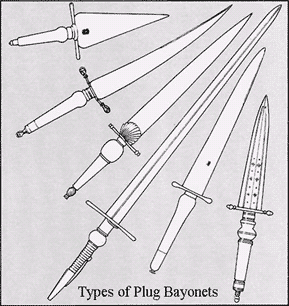 |
affixed to a tapering wooden handle of about the same length. The handle could be inserted into the muzzle of a musket to provide a handy thrusting weapon in close-quarter fighting and against cavalry. The weapon spread gradually throughout Europe and the musket and bayonet in time supplanted the pike as the principal infantry weapon. |
The plug bayonet, as it came to be called, suffered from serious defects. Once plugged into the bore of the musket, no shot could be fired. If wedged too firmly into the bore, it could be extremely difficult to remove. If not held firmly enough by the bore, the bayonet could fall out or be left lodged in the enemy’s body when withdrawal was attempted. It was not an effective weapon and something better was |
needed. By the closing decades of the 17th century, a bayonet had been developed with loose rings on the haft to fit around the barrel. This too was unsatisfactory but the socket bayonet was introduced into French service in 1688. This design had a sleeve to be slipped over the muzzle of the musket and was fixed in place by a stud on the barrel that fitted into a right-angle slot in the socket. This provided firm locking of the bayonet to the musket and, as the blade of the bayonet was below the barrel, allowed the musket to be fired with the bayonet fixed. Normally the socket bayonet blade was triangular in cross-section and was useful only in thrusting at the enemy.
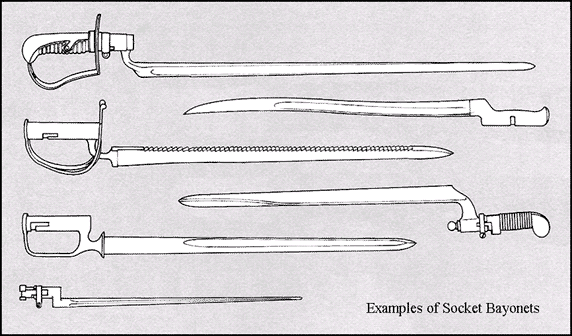
Bayonets with flat blades, single or double edged, appeared in the first half of the 18th century. Being heavier than the triangular bayonets, they tended to make firearms muzzle-heavy and their use was generally confined to the shorter arms – musketoons, rifles and carbines. Some had swordlike handles in lieu of sockets and were fixed to a stud on the barrel by means of a spring catch. The first regular use of sword bayonets was probably by British rifle regiments in the early-1800s and they had become standard by the mid-19th century. Some sword bayonets had saw teeth on the
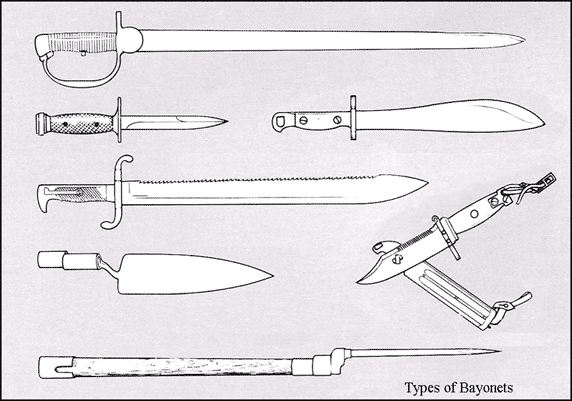
back of the blade and could be employed as pioneer or engineer tools. Others were also configured to serve purposes in addition to fighting. Experiments were made with rod bayonets that could be retracted into the stock and folding bayonets attached to the barrel have been a feature of some firearms, including quite modern Russian models. The length of bayonet blades was reduced as the use of the bayonet as an anti-cavalry weapon became less important.
When the bayonet was at the apex of its usefulness in the 18th and 19th centuries, the defensive formation of the ‘square’ confronted the advancing infantry with a formidable rank of bayonets and a second rank of muskets firing or preparing to fire. In an engagement in open ground, the sight of infantry charging often caused those under attack to lose their nerve and flee from the threat of the bayonet. In both attack and defence, it was a matter of which side had the better discipline. If the
defence stood its ground and the attack persevered with its advance, the bayonet was a deadly weapon in the ensuing melee. |
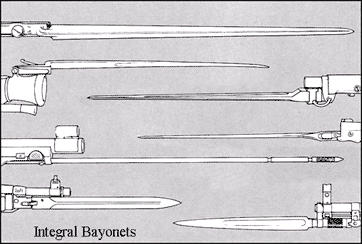 |
The bayonet remained a weapon of particular importance while military firearms were single shot and tactics were based on close-quarter fighting in mass formations. The Crimean War (1854-1856) was not notable for infantry actions but hand-to-hand fighting with bayonets sometimes determined the outcome of battles in the American Civil War of 1861 - |
1865. With the development of the repeating rifle, bayonets became more of an offensive weapon but Boer tactics and terrain and vegetation characteristics rendered bayonets of little account in the South African War (1899-1902). The importance of the bayonet was revived in the trench fighting and mass attacks on the Western Front in the 1914-1918 War – to the extent that small bayonets were sometimes fixed to the Webley Mk. VI revolvers carried by officers of the British, Dominion and Colonial forces.
Mass bayonet attacks and trench warfare were not features of the 1939-1945 War and the Korean War but there were still engagements involving use of the bayonet in close-quarter confrontations. Although some armies, including the U.S. Army, by this time apparently no longer considered training in bayonet fighting as a necessary preparation for war, the bayonet still had a place as the weapon of last resort.
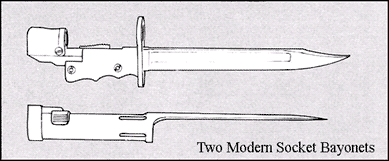 |
Bayonet fighting relied upon a few simple routines and a great deal of energy and aggression. The rifle with its fixed bayonet was used to penetrate the enemy’s body, to batter him about the head or in the groin with butt-strokes and to parry his bayonet thrusts. Even when the value of |
the bayonet in warfare had declined, bayonet training was still practiced in some armies to inculcate a spirit of aggression in the soldier.
Wars in the latter half of the 20th century and these opening years of the 21st century, including Viet Nam, the recent wars in the territory of the former Yugoslavia and the campaigns in Iraq and Afghanistan, have not seen the bayonet as a weapon of any significance. Given the nature of modern warfare as it appears at the present time, it seems unlikely that bayonets will play a part in future wars. They have perhaps gone the way of those other weapons of similar character, the sword and the lance.
While soldiers of all Branches and Services of the Army, except the Medical Corps, wear the bayonet as a sidearm, it has been only the infantrymen – and formerly in the cavalry, the light horsemen of mounted infantry and mounted rifle regiments – who used the weapon in action. In its time, it was a valued adjunct to the rifle, and later the machine carbine. It now appears likely that the time may come when the bayonet will no longer becarried in action. The question will then arise, ‘what does the infantryman do |
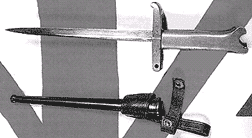
Pritchard's Bayonet for the Webley Mk.VI Revolver |
when, confronted at extremely close quarters by an enemy bent upon killing him, he has an empty magazine and no time to reload?’